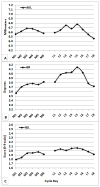A comparison of cyclic variations in anterior knee laxity, genu recurvatum, and general joint laxity across the menstrual cycle
- PMID: 20872575
- PMCID: PMC2947333
- DOI: 10.1002/jor.21145
A comparison of cyclic variations in anterior knee laxity, genu recurvatum, and general joint laxity across the menstrual cycle
Abstract
Changes in anterior knee laxity (AKL), genu recurvatum (GR) and general joint laxity (GJL) were quantified across days of the early follicular and early luteal phases of the menstrual cycle in 66 females, and the similarity in their pattern of cyclic variations examined. Laxity was measured on each of the first 6 days of menses (M1-M6) and the first 8 days following ovulation (L1-L8) over two cycles. The largest mean differences were observed between L5 and L8 for AKL (0.32 mm), and between L5 and M1 for GR (0.56°) and GJL (0.26) (p < 0.013). At the individual level, mean absolute cyclic changes in AKL (1.8 ± 0.7 mm, 1.6 ± 0.7 mm), GR (2.8 ± 1.0°, 2.4 ± 1.0°), and GJL (1.1 ± 1.1, 0.7 ± 1.0) were more apparent, with minimum, maximum and delta values being quite consistent from month to month (ICC(2,3) = 0.51-0.98). Although the average daily pattern of change in laxity was quite similar between variables (Spearman correlation range 0.61 and 0.90), correlations between laxity measures at the individual level were much lower (range -0.07 to 0.43). Substantial, similar, and reproducible cyclic changes in AKL, GR, and GJL were observed across the menstrual cycle, with the magnitude and pattern of cyclic changes varying considerably among females.
© 2010 Orthopaedic Research Society.
Figures
References
-
- Griffin LY, Albohm MJ, Arendt EA, et al. Update on ACL Prevention: Theoretical and Practical Guidelines. Am J Sports Med. 2006;34:1512–1532. - PubMed
-
- Beynnon BD, Bernstein I, Belisle A, et al. The Effect of Estradiol and Progesterone on Knee and Ankle Joint Laxity. Am J Sports Med. 2005;33:1298–1304. - PubMed
-
- Rozzi SL, Lephart SM, Gear WS, et al. Knee joint laxity and neuromuscular characteristics of male and female soccer and basketball players. Am J Sports Med. 1999;27:312–319. - PubMed
-
- Trimble MH, Bishop MD, Buckley BD, et al. The relationship between clinical measurements of lower extremity posture and tibial translation. Clin Biomech. 2002;17:286–290. - PubMed
Publication types
MeSH terms
Grants and funding
LinkOut - more resources
Full Text Sources




